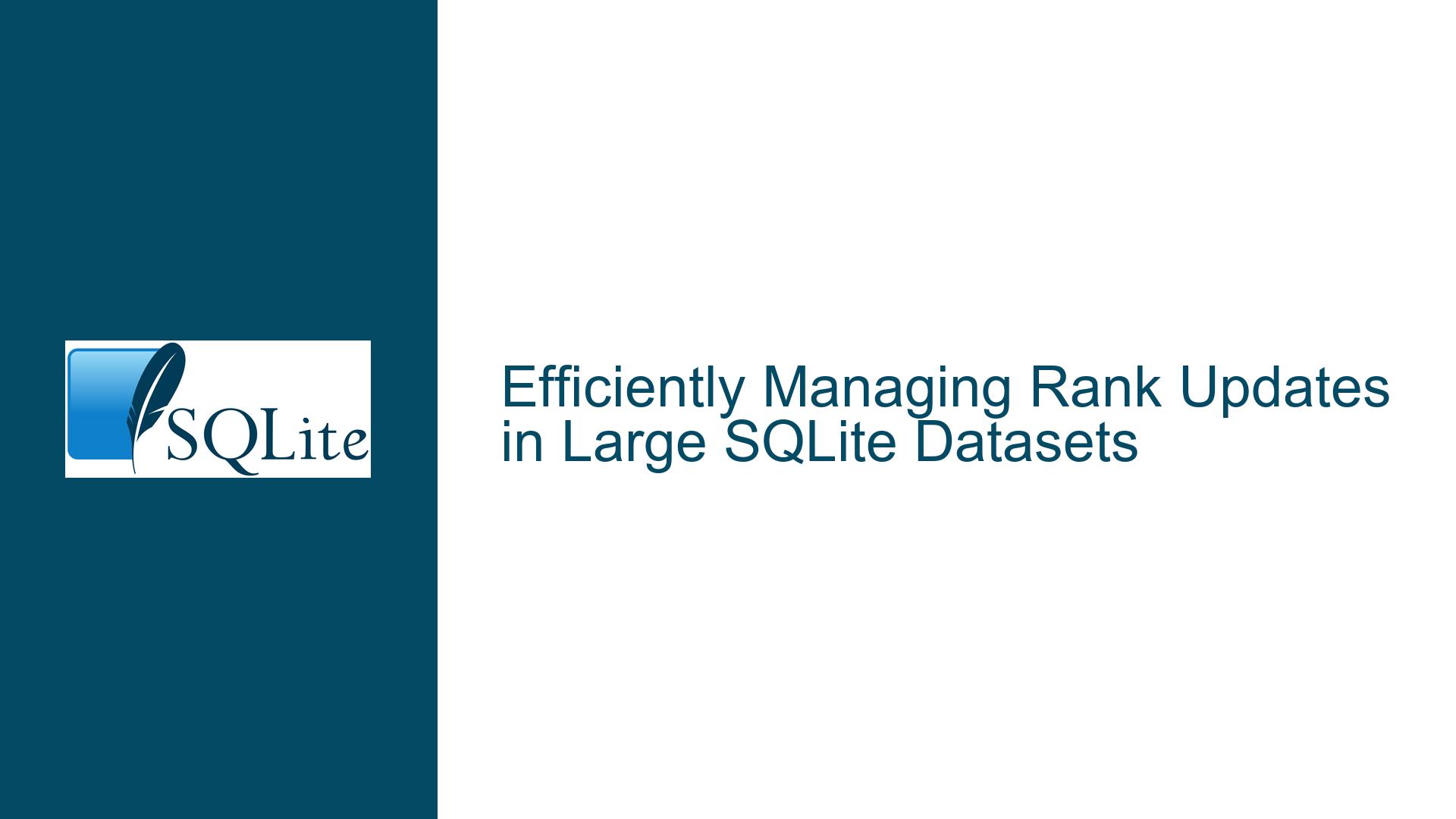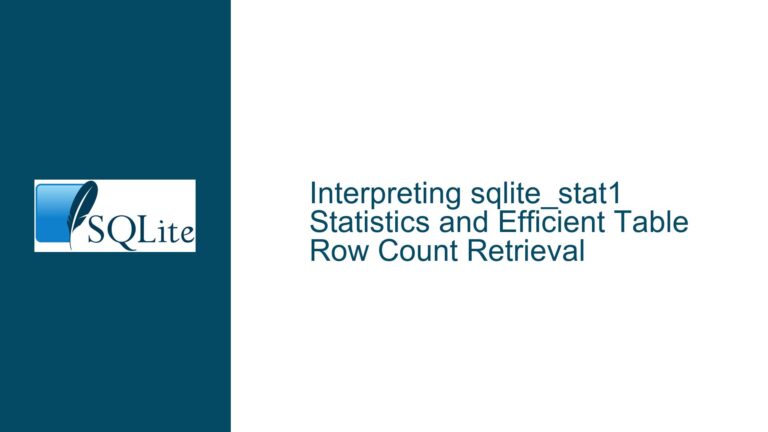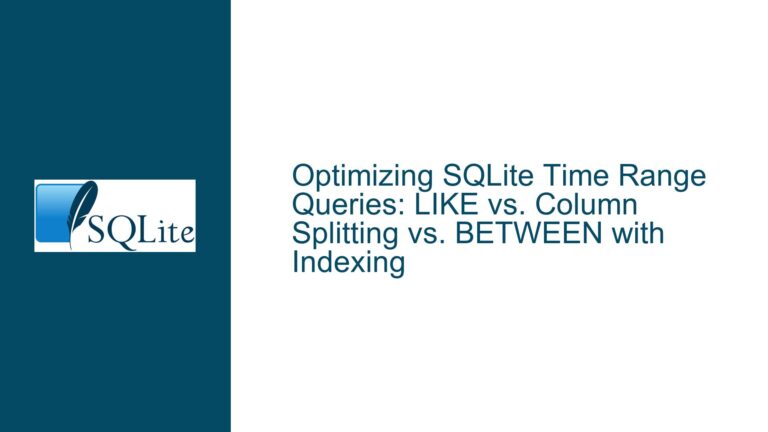Efficiently Managing Rank Updates in Large SQLite Datasets
Frequent Rank Updates in Large Datasets Leading to Performance Bottlenecks
When dealing with large datasets in SQLite, particularly those requiring frequent updates to item ranks, performance bottlenecks can quickly become a significant issue. The core problem arises when the dataset contains a large number of items, each assigned a unique and continuous rank. These ranks are often used for ordering, and when an item’s rank changes, it necessitates updating the ranks of many other items to maintain the continuity and uniqueness of the ranks. This operation can be computationally expensive, especially when the dataset contains hundreds of thousands of items.
The primary challenge is to maintain the integrity of the rank system while minimizing the computational overhead associated with rank updates. The traditional approach of using the id column as the rank and updating it directly leads to a time complexity of O(m-n), where m and n are the old and new ranks of the item being updated. This approach becomes impractical when the dataset is large, and rank updates are frequent.
Interrupted Write Operations and Index Corruption
One of the primary causes of performance degradation in this scenario is the need to update a large number of rows whenever a single item’s rank is changed. When the id column is used as the rank, updating an item’s rank from m to n requires altering the id of every item between m and n. This operation not only involves a significant amount of I/O but also requires rebalancing the B-tree index, which can be very expensive in terms of both time and resources.
Another potential issue is the risk of index corruption, especially if the database is not properly managed. Frequent updates to the id column can lead to fragmentation of the index, which can further degrade performance. Additionally, if the database is not properly backed up, there is a risk of data loss or corruption in the event of a power failure or other interruption during a rank update operation.
Implementing Floating-Point Ranks and Indexed Linked Lists
To address the performance bottlenecks associated with frequent rank updates, several strategies can be employed. One effective approach is to use floating-point numbers for ranks instead of integers. This allows for the insertion of new ranks between existing ranks without the need to update the ranks of other items. For example, if an item needs to be moved from rank 100 to rank 50, it can be assigned a rank of 49.5, which lies between ranks 49 and 50. This approach significantly reduces the number of rows that need to be updated, as only the rank of the item being moved needs to be changed.
However, the floating-point approach has its limitations. Over time, the precision of floating-point numbers can become an issue, especially if ranks are frequently updated. To mitigate this, a hybrid approach can be used, where ranks are periodically renumbered to restore the use of integer ranks. This can be done during periods of low activity to minimize the impact on performance.
Another approach is to use an indexed linked list to manage the ranks. In this approach, each item is assigned a rank, but the ranks are not stored as a continuous sequence of integers. Instead, each item contains a reference to the next item in the sequence, effectively creating a linked list. This allows for efficient updates to the rank of an item, as only the references of the affected items need to be updated. However, this approach requires additional indexing to maintain the order of the items, which can add some overhead to queries that require ordered results.
To implement an indexed linked list in SQLite, a table can be created with the following structure:
CREATE TABLE dataset (
id INTEGER PRIMARY KEY,
item TEXT,
next_id INTEGER,
FOREIGN KEY (next_id) REFERENCES dataset(id)
);
In this table, the next_id column contains the id of the next item in the sequence. To update the rank of an item, only the next_id values of the affected items need to be updated. For example, to move an item from rank m to rank n, the following steps can be taken:
- Update the
next_idof the item at rankm-1to point to the item at rankm+1. - Update the
next_idof the item at rankn-1to point to the item being moved. - Update the
next_idof the item being moved to point to the item at rankn.
This approach reduces the number of rows that need to be updated from O(m-n) to a constant number, regardless of the size of the dataset. However, it does require additional indexing to maintain the order of the items, which can add some overhead to queries that require ordered results.
To further optimize the performance of rank updates, the database can be configured to use a write-ahead log (WAL) journal mode. This mode allows for concurrent reads and writes, which can significantly improve performance in scenarios where rank updates are frequent. The WAL mode can be enabled using the following command:
PRAGMA journal_mode=WAL;
In addition to using the WAL mode, it is also important to ensure that the database is properly backed up to prevent data loss in the event of a power failure or other interruption. SQLite provides several options for backing up the database, including the VACUUM command, which can be used to rebuild the database file and reduce fragmentation.
Finally, it is important to periodically renumber the ranks to restore the use of integer ranks and reduce the precision issues associated with floating-point ranks. This can be done using a procedure that deletes all the rows in the table and creates new ones with integer ranks. This procedure can be called during periods of low activity to minimize the impact on performance.
In conclusion, managing rank updates in large SQLite datasets requires a combination of strategies to minimize the computational overhead and maintain the integrity of the rank system. By using floating-point ranks, indexed linked lists, and optimizing the database configuration, it is possible to achieve efficient and reliable rank updates even in large datasets.






